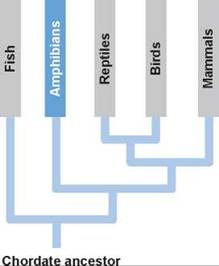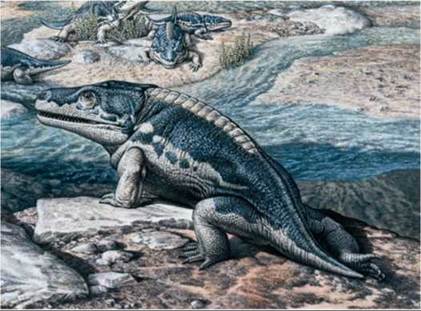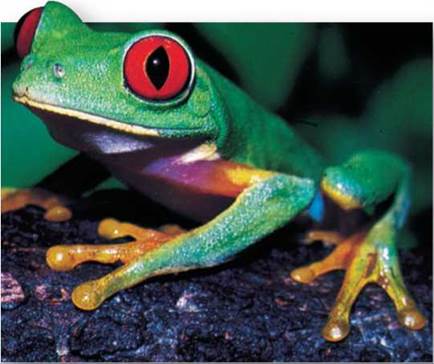THE LIVING WORLD
Unit Five. Evolution of Animal Life
20. History of the Vertebrates
20.5. Amphibians Invade the Land
Frogs, salamanders, and caecilians, the dampskinned vertebrates, are direct descendants of fishes. They are the sole survivors of a very successful group, the amphibians, the first vertebrates to walk on land. Amphibians likely evolved from the lobe-finned fishes, fish with paired fins that consist of a long, fleshy, muscular lobe supported by a central core of bones that form fully articulated joints with one another. In 2006, the discovery of a new fossil fish (genus Tiktaalik) exhibited a further step in the transition between fish and amphibians (figure 20.15 2).


Figure 20.15. A key adaptation of amphibians: the evolution of legs.
In ray-finned fishes, the fins contain only bony rays. 1 In lobe-finned fish, the fins have a central core of bones (inside a fleshy lobe) in addition to bony rays. Some lobe-finned fishes could move out onto land. 2 In the incomplete fossil of Tiktaalik (which did not contain the hindlimbs), the shoulder, forearm, and wrist bones were like those of amphibians, but the end of the limb was like that of lobe-finned fishes. 3 In primitive amphibians, the positions of the limb bones are shifted, and bony "toes" are present.
Amphibians have five key characteristics that allowed them to successfully invade the land:
1. Legs. Frogs and salamanders have four legs and can move about on land quite well. The way in which legs are thought to have evolved from fins is illustrated in figure 20.15. Notice that the arrangement of the bones in the early amphibian limbs 3 is similar to the arrangement found in the lobe-finned fish 1 and in Tiktaalik 2. Legs were one of the key adaptations to life on land.
2. Lungs. Most amphibians possess a pair of lungs, although the internal surfaces are poorly developed. Lungs were necessary because the delicate structure of fish gills requires the buoyancy of water to support them.
3. Cutaneous respiration. Frogs, salamanders, and caecilians all supplement the use of lungs by respiring directly across their skin, which is kept moist and provides an extensive surface area. This mode of respiration limits the body size of amphibians, because it is only efficient for a high surface-to-volume ratio.
4. Pulmonary veins. After blood is pumped through the lungs, two large veins called pulmonary veins return the aerated blood to the heart for repumping. This allows aerated blood to be pumped to tissues at a much higher pressure than when it leaves the lungs.
5. Partially divided heart. Greater amounts of oxygen are required by muscles for movement and support on land. The chambers of the amphibian heart are separated by a dividing wall that helps prevent aerated blood from the lungs from mixing with nonaerated blood being returned to the heart from the rest of the body. This separates the blood circulation into two separate paths, pulmonary and systemic. The separation is incomplete, however, and some mixing does occur.
History of Amphibians
Amphibians were the dominant land vertebrates for 100 million years (figure 20.16). They first became common in the Carboniferous period, when much of the land was covered by lowland tropical swamps. Amphibians reached their greatest diversity during the mid-Permian period, when 40 families existed. Sixty percent of them were fully terrestrial, with bony plates and armor covering their bodies. Many of these terrestrial amphibians grew to be very large—some as big as a pony! After the great Permian extinction, the terrestrial forms began to decline, and by the time dinosaurs evolved, only 15 families remained, all aquatic.

Figure 20.16. A terrestrial amphibian of the early Permian.
By the Permian period, many types of amphibians were fully terrestrial, and some, like this Cacops, had extensive body armor.
Approximately 4,850 species of amphibians exist today (figure 20.17), in 37 different families and 3 orders, all descended from three aquatic families that survived competition with reptiles by reinvading the water. The three living orders of the class Amphibia are: Anura, frogs, and toads; Urodela, salamanders, and newts; and Apoda, caecilians (table 20.3). Most of today’s amphibians exhibit the ancestral reproductive cycle: Eggs laid in water hatch into aquatic larval forms with gills, which eventually undergo metamorphosis into adult forms with lungs. Many amphibians exhibit exceptions to this pattern, but all are tied to moist if not aquatic environments due to their thin skin. In moist habitats, particularly in the tropics, amphibians are often the most abundant and successful vertebrates to be found today.

Figure 20.17. A representative of today's amphibians.
This red-eyed tree frog, Agalychnis callidryas, is a member of the group of amphibians that includes frogs and toads (order Anura).
TABLE 20.3. ORDERS OF AMPHIBIANS

Key Learning Outcome 20.5. Amphibians were the first vertebrates to successfully invade land. They developed legs, lungs, and the pulmonary vein, which allowed them to repump oxygenated blood and thus deliver oxygen far more efficiently to the body's muscles.